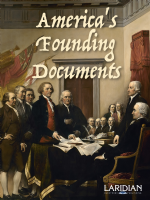$19.99
If you are already a Laridian customer, log in above and we can tell you if you own this product.
Preview Book
Preview the table of contents and a limited selection of text from this book.

America's Founding Documents
$19.99
Buy It Once, Use It On These Platforms
Description
This unique collection of historical documents gives the reader insight into the events and historical setting for the formation of the United States of America. It includes early organization documents for the colonies, early legislation, Supreme Court rulings, speeches, and other material that addresses issues such as slavery, Native American displacement, westward expansion, and more. In these documents we see both the wisdom and insight of the Founders, along with what we perceive today as their failings in the way that certain issues were addressed.
This material is presented without commentary. The intent is to provide the reader with the primary source material that we normally only see in the form of brief snippets and quotes in history books.
Because of the period of time covered and the myriad points of view represented by the Founders, no collection like this can be complete. But there is more original source material here than one would normally find in one place.
Features
Magna Carta (1215)
Originally a peace treaty between King John of England and a group of barons, Magna Carta (Latin for Great Charter) gained a mythological significance as an ancient English constitution that protected individual freedoms. Though technically incorrect, this belief persisted into the 18th century and had an influence on the formation of the American Constitution and Bill of Rights.
Virginia Charters (1606, 1609, 1612)
In these three charters, authority is granted by King James I for the Virginia Company to govern its colony. Each subsequent charter grants additional territory to the Virginia Company.
Instructions for the Virginia Colony (1606)
Attempts to settle the American continent in the 16th century had generally failed. The early 17th century brought a number of joint stock companies to its shores with the belief that a profit motive might make them more successful. These instructions given to the Virginia Company seek to address the issues that caused earlier ventures to stumble.
Mayflower Compact, The (1620)
The Mayflower Compact was the first governing document of the Plymouth Colony. When storms forced them to Cape Cod instead of Virginia, the Pilgrims aboard the Mayflower realized they would not be under the legal jurisdiction of the Virginia Company. They chose to establish their own government by means of this Compact.
Charter of New England (1620)
In 1620, the Plymouth Council for New England, an English joint stock company, was granted a charter to establish settlements north of the 40th parallel and south of the 48th.
Massachusetts Bay Company Charter (1629)
The Massachusetts Bay Company was a joint stock trading company chartered by the English crown in 1629 to colonize a vast area in New England extending from 3 mi (4.8 km) miles north of the Merrimack River to 3 mi miles south of the Charles River. It was quickly taken over by a group of Puritans, under the leadership of John Winthrop, who wished to establish a religious community in the New World.
Fundamental Orders of Connecticut, The (1639)
Considered by some to be the first written Constitution, this document describes the government of the Connecticut Colony and is the source of that state's nickname, The Constitution State.
New England Articles of Confederation (1643)
In 1643, the English colonies of Massachusetts Bay, Plymouth, Connecticut, and New Haven formed a military alliance against the Native Americans and Dutch colonies. This document describes their agreement.
Maryland Toleration Act, The (1649)
This "Act Concerning Religion" mandated religious tolerance for Christians and is one of the early attempts to assure some degree of religious tolerance in the colonies. While it guaranteed freedom of worship to trinitarian Christians, it sentenced anyone to death who denied the deity of Christ.
Rhode Island Royal Charter (1663)
The Rhode Island Royal Charter of 1663 gave English royal recognition to the Colony of Rhode Island and Providence Plantations, providing a foundation for the government, and outlining broad freedoms for the inhabitants of that colony. As the guiding document for the government of Rhode Island for 180 years, it was the oldest constitutional charter in the world at the time of its retirement in 1843.
Albany Plan of Union (1754)
The Albany Plan of Union was put forth by Benjamin Franklin at the Albany Congress in July 1754 in Albany, New York. It proposed to create a unified government for the Thirteen Colonies. Representatives of several northern and mid-Atlantic colonies assembled to plan their defense during the French and Indian War. The Plan was one of multiple early attempts to form a union of the colonies "under one government as far as might be necessary defense and other general important purposes."
Second Continental Congress Declaration of the Causes and Necessity of Taking up Arms (1775)
The Declaration describes what colonists viewed as the unconstitutional effort of the British Parliament to extend its jurisdiction into the colonies following the Seven Years' War. It included such objectionable policies as taxation without representation, extended use of vice admiralty courts, the several Coercive Acts, and the Declaratory Act. It describes how the colonists had repeatedly petitioned for the redress of their grievances. Even though British troops were sent to enforce the unconstitutional acts, the Declaration insisted that the colonists did not seek independence from the mother country. They had taken up arms "in defence of the Freedom that is our Birthright and which we ever enjoyed until the late Violation of it", and will "lay them down when Hostilities shall cease on the part of the Aggressors".
Common Sense
Thomas Paine's plainly worded, well-reasoned, and widely read pamphlet is considered by many to be the primary means by which the general public was moved to support the cause of independence from Great Britain. It remains one of the best-selling if not the best selling American book in history.
Declaration of Independence (1776)
Probably our most beloved founding document, the Declaration was adopted by the Continental Congress on July 4, 1776, and announced that the thirteen American colonies, then at war with Great Britain, regarded themselves as thirteen newly independent sovereign states, and no longer a part of the British Empire. Instead they formed a new nation — the United States of America.
The American Crisis
A collection of articles written by Thomas Paine during and in support of the Revolutionary War, this book begins with the familiar line, "These are the times that try men's souls: The summer soldier and the sunshine patriot will, in this crisis, shrink from the service of his country; but he that stands it now, deserves the love and thanks of man and woman." George Washington had the opening essay read to his troops before crossing the Delaware River on Christmas Day, 1776, to engage the British at Trenton, NJ.
Articles of Confederation (1777)
The Articles of Confederation, formally the Articles of Confederation and Perpetual Union, served as the first constitution of the thirteen original states of the United States of America. The Second Continental Congress appointed a committee July 12, 1776 to draft the Articles, and an approved version was sent to the states for ratification in late 1777. Formal ratification by all thirteen states was completed in early 1781. The Articles provided a system for the Continental Congress to direct the American Revolutionary War, conduct diplomacy with Europe and deal with territorial issues and Native American relations. But the weakness of the government created by the Articles became a matter of concern for key nationalists, leading to its eventual replacement by the United States Constitution.
Treaty of Alliance with France (1778)
The Treaty of Alliance with France was the defensive alliance between France and the United States of America, formed in the midst of the American Revolutionary War, which promised France’s military support in case of attack by British forces indefinitely into the future. Delegates of King Louis XVI of France and the Second Continental Congress, who represented the United States government at this time, signed the treaty along with The Franco-American Treaty of Amity and Commerce on February 6, 1778.
Treaty of Paris (1783)
The Treaty of Paris, signed in Paris by representatives of King George III of Great Britain and representatives of the United States of America on September 3, 1783, ended the American Revolutionary War. This treaty, along with the separate peace treaties between Great Britain and the nations that supported the American cause: France, Spain and the Dutch Republic, are known collectively as the Peace of Paris. Its territorial provisions were "exceedingly generous" to the United States in terms of enlarged boundaries.
Constitution of the United States (1787)
The United States Constitution is the supreme law of the United States of America. The seven original articles of the Constitution delineate the national framework of government. Its first three articles establish the doctrine of the separation of powers, whereby the federal government is divided into three branches: the legislative, the executive, and the judicial. Articles Four, Five and Six establish concepts of federalism, describing the rights and responsibilities of state governments and of the states in relationship to the federal government. Article Seven establishes the procedure subsequently used by the thirteen States to ratify it.
Federalist Papers, The (1787)
A collection of 85 articles and essays written by Alexander Hamilton, James Madison, and John Jay promoting the ratification of the United States Constitution. In Federalist No. 1, the authors stressed the import of these documents beyond promoting ratification of the Constitution: "It has been frequently remarked, that it seems to have been reserved to the people of this country, by their conduct and example, to decide the important question, whether societies of men are really capable or not, of establishing good government from reflection and choice, or whether they are forever destined to depend, for their political constitutions, on accident and force."
Northwest Ordinance (1787)
The Northwest Ordinance created the Northwest Territory, the first organized territory of the United States, from lands beyond the Appalachian Mountains, between British Canada and the Great Lakes to the north and the Ohio River to the south. The upper Mississippi River formed the Territory's western boundary. Possibly the single most important piece of legislation passed by the earlier Continental Congresses and the Confederation Congress. It established the precedent by which the Federal government was sovereign and would expand westward across North America by admission of new states, rather than expanding existing states and their established sovereignty under the Articles of Confederation. It is also important regarding American public domain lands. The prohibition of slavery in the territory had the practical effect of establishing the Ohio River as the boundary between free and slave territory in the region between the Appalachian Mountains and the Mississippi River. This division helped set the stage for national competition over admitting free and slave states, the basis of a critical question in American politics in the 19th century until the Civil War.
Virginia Plan (1787)
The Virginia Plan was a proposal by Virginia delegates for a bicameral legislative branch. The plan was drafted by James Madison while he waited for a quorum to assemble at the Constitutional Convention of 1787. It was notable for its role in setting the overall agenda for debate in the convention and, in particular, for setting forth the idea of population-weighted representation in the proposed national legislature. The Plan proposed a legislative branch consisting of two chambers (bicameral legislature), with the dual principles of rotation in office and recall applied to the lower house of the national legislature. Each state would be represented in proportion to their "Quotas of contribution, or to the number of free inhabitants." States with large populations, like Virginia (the most populous state at the time), would thus have more representatives than smaller states.
Bill of Rights (1791)
The Bill of Rights is the collective name for the first ten amendments to the United States Constitution. Proposed to assuage the fears of Anti-Federalists who had opposed Constitutional ratification, the amendments guarantee a number of personal freedoms, limit the government's power, and reserve certain powers to the states and the public. Originally the amendments applied only to the federal government, however, most were subsequently applied to the government of each state by way of the Fourteenth Amendment, through a process known as incorporation.
President George Washington's Farewell Address (1796)
George Washington's Farewell Address is a letter written by President George Washington to "The People of the United States of America". Washington wrote the letter near the end of his second term as President, before his retirement to his home Mount Vernon. It is a classic statement of republicanism, warning Americans of the political dangers they can and must avoid if they are to remain true to their values.
Alien and Sedition Acts (1798)
The Alien and Sedition Acts were four bills that were passed by the Federalists in the 5th United States Congress and signed into law by President John Adams in 1798, as a result of the French Revolution and during an undeclared naval war with France, later known as the Quasi-War. Opposition to Federalists, spurred on by Democratic-Republicans, reached new heights at this time with the Democratic-Republicans supporting France still in the midst of the French Revolution. Some appeared to desire an event similar to the French Revolution to come to the United States to overthrow the government. The Acts were purported to strengthen national security, but critics argued that they were primarily an attempt to suppress voters who disagreed with the Federalist party.
Jefferson's Secret Message to Congress Regarding the Lewis & Clark Expedition (1803)
In this secret message of January 18, 1803, President Jefferson asked Congress for $2,500 to explore the West-all the way to the Pacific Ocean. At the time, the territory did not belong to the United States. Congress agreed to fund the expedition that would be led by Meriwether Lewis and William Clark. The modesty of the request, couched principally in terms of promoting commerce, belied the grandeur of the vision behind it. Jefferson had long been fascinated with the West and dreamed of a United States that would stretch across the entire continent.
Louisiana Purchase Treaty (1803)
The Louisiana Purchase Treaty was signed on April 30, 1803 and announced to the American people on July 4. Though challenged as to the legality of the purchase, Jefferson maintained the right to do so citing the presidential authority to sign treaties. The United States Senate ratified the treaty with a vote of twenty-four to seven on October 20.
Marbury v. Madison (1803)
Marbury v. Madison, (1803), was a landmark United States Supreme Court case in which the Court formed the basis for the exercise of judicial review in the United States under Article III of the Constitution. The decision helped define the boundary between the executive and judicial branches of the American government.
Missouri Compromise (1820)
The Missouri Compromise was a federal statute in the United States that regulated slavery in the country's western territories. The compromise, devised by Henry Clay, was agreed to by the pro-slavery and antislavery factions in the United States Congress and passed as a law in 1820. It prohibited slavery in the former Louisiana Territory north of the 36 degree 30 minute north parallel, except within the boundaries of the proposed state of Missouri. The Missouri Compromise was effectively repealed by the Kansas–Nebraska Act.
Monroe Doctrine (1823)
The Monroe Doctrine was a U.S. foreign policy regarding European countries in 1823. It stated that further efforts by European nations to colonize land or interfere with states in North or South America would be viewed as acts of aggression, requiring U.S. intervention. At the same time, the doctrine noted that the United States would neither interfere with existing European colonies nor meddle in the internal concerns of European countries.
Andrew Jackson's Message to Congress On Indian Removal (1830)
On December 6, 1830, President Andrew Jackson addressed Congress to call for the removal of Native Americans from eastern states for resettlement west of the Mississippi River. Citizens in the state of Georgia, for example, had discovered gold on Native American land, and incidents of violence between Native Americans and their European neighbors was common.
Kansas-Nebraska Act (1854)
The Kansas–Nebraska Act of 1854 created the territories of Kansas and Nebraska, opening new lands for settlement. It had the effect of repealing the Missouri Compromise of 1820 by allowing white male settlers in those territories to determine through popular sovereignty whether they would allow slavery within each territory. The initial purpose of the Kansas–Nebraska Act was to open up many thousands of new farms and make feasible a Midwestern Transcontinental Railroad. It became a problem when popular sovereignty was written into the proposal so that the voters of the moment would decide whether slavery would be allowed or not. The result was that pro- and anti-slavery elements flooded into Kansas with the goal of voting slavery up or down.
Dred Scott v. Sanford (1857)
Dred Scott v. Sandford, 60 U.S. 393 (1857), was a landmark decision by the U.S. Supreme Court in which the Court held that African Americans, whether enslaved or free, could not be American citizens and therefore had no standing to sue in federal court and that the federal government had no power to regulate slavery in the federal territories acquired after the creation of the United States. Dred Scott, an enslaved African American man who had been taken by his owners to free states and territories, attempted to sue for his freedom. In a 7–2 decision written by Chief Justice Roger B. Taney, the Court denied Scott's request. For only the second time in its history the Supreme Court ruled an Act of Congress to be unconstitutional.
Constitution of the Confederate States of America (1861)
The Constitution of the Confederate States of America was adopted on March 11, 1861. For the most part, it is a copy of the United States Constitution, the exceptions primarily related to issues surrounding slavery and states' rights.
Emancipation Proclamation (1863)
The Emancipation Proclamation was a presidential proclamation and executive order issued by President Abraham Lincoln on January 1, 1863. It proclaimed the freedom of slaves in the ten states that were still in rebellion. Because it was issued under the President's war powers, it necessarily excluded areas not in rebellion - it applied to more than 3 million of the 4 million slaves in the U.S. at the time.
Gettysburg Address (1863)
The Gettysburg Address was delivered by President Lincoln during the American Civil War, on the afternoon of Thursday, November 19, 1863, at the dedication of the Soldiers' National Cemetery in Gettysburg, Pennsylvania, four and a half months after the Union armies defeated those of the Confederacy at the Battle of Gettysburg. In just over two minutes, Lincoln reiterated the principles of human equality espoused by the Declaration of Independence and proclaimed the Civil War as a struggle for the preservation of the Union sundered by the secession crisis, with "a new birth of freedom" that would bring true equality to all of its citizens.
Amendments to the Constitution (1791-present)
Since the Constitution came into force in 1789, it has been amended twenty-seven times. In general, the first ten amendments, known collectively as the Bill of Rights, offer specific protections of individual liberty and justice and place restrictions on the powers of government. The majority of the seventeen later amendments expand individual civil rights. Others address issues related to federal authority or modify government processes and procedures.
Presidential Inaugural Addresses (1789-1873)
The inaugural addresses of each President from George Washington through Ulysses S. Grant's second term. Some are lengthy; some brief. Many express a humility that is rare among politicians today. All reflect the incoming President's thoughts on the issues on the forefront of his mind as he takes the oath to uphold the Constitution of the new nation.
System Requirements
Installed size (unless otherwise indicated): Approximately 2.375 MB. iPhone, iPad, and iPod touch Requires iPhone, iPod touch, or iPad running latest version of iOS. Download size: 2.375 MB. Android Requires Android OS 4.4 or later. Download size: 2.375 MB. Windows Requires Windows 10, 11 or later. Download size: 2.375 MB. macOS Requires macOS 10.13 or later. Download size: 2.375 MB.
The Fine Print
Copyright © 2010-2025 by Laridian, Inc. All Rights Reserved.
Laridian and PocketBible are registered trademarks of Laridian, Inc. DailyReader, MyBible, Memorize!, PrayerPartner, eTract, BookBuilder, VerseLinker, iPocketBible, DocAnalyzer, Change the way you look at the Bible, and The Bible. Anywhere. are trademarks of Laridian, Inc. Other marks are the property of their respective owners.
About You
- You are viewing the mobile version of our website.
- You are not logged in.
- Your IP Address: 216.73.216.151
- Site IP Address: 69.167.186.191
Social Media
Like and follow us on Facebook.
Follow us on MeWe.
Stay Informed
We announce new products via email. If you ask to be removed from any of our mailings, you will not receive these notifications. If your email address changes, make sure you change it here, too.
From time to time we post things on our blog, on MeWe, and on Facebook.
The Fine Print
Copyright © 2010-2025 by Laridian, Inc. All Rights Reserved.
Laridian, PocketBible, and MyBible are registered trademarks of Laridian, Inc. DailyReader, Memorize!, PrayerPartner, eTract, BookBuilder, VerseLinker, iPocketBible, DocAnalyzer, Change the way you look at the Bible, and The Bible. Anywhere. are trademarks of Laridian, Inc. Other marks are the property of their respective owners.
Products by Platform
Bible Reader Software
BookBuilder Software
- BookBuilder for Windows
- BookBuilder Pro for Windows
- BookBuilder for macOS
- BookBuilder Pro for macOS
- Self-Publishing Info
About Laridian
Products by Type
Your Account
- You are not logged in.
- Your IP Address: 216.73.216.151
- Site IP Address: 69.167.186.191
- Your Account Information
- Your Order History
- Your Downloads
- Your Notes, Highlights, and Bookmarks
- Your BookBuilder Books
- Your Shopping Cart
- Register Purchase from a Store
Best Ways to Get Help
You can get the fastest help by helping yourself.
- Make sure you download and install the PocketBible app that is required to read the Bibles or books you bought
- Read the confirmation email we send you when you make a purchase
- Read the help that's built into each of our products
- Look through our Frequently Asked Questions
- Submit a Support Ticket
- Email us at support@laridian.com

 America's Founding Documents
America's Founding Documents




